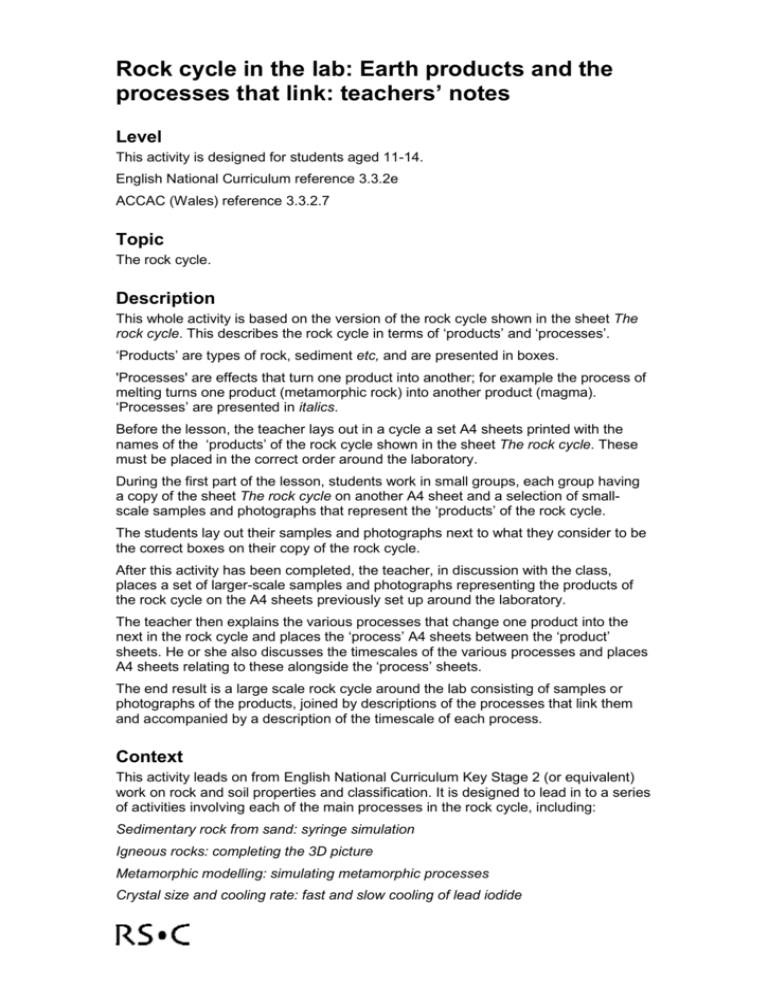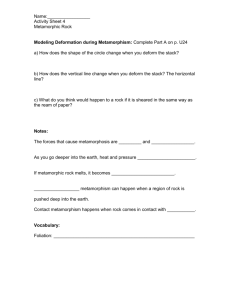
Rock cycle in the lab: Earth products and the
processes that link: teachers’ notes
Level
This activity is designed for students aged 11-14.
English National Curriculum reference 3.3.2e
ACCAC (Wales) reference 3.3.2.7
Topic
The rock cycle.
Description
This whole activity is based on the version of the rock cycle shown in the sheet The
rock cycle. This describes the rock cycle in terms of ‘products’ and ‘processes’.
‘Products’ are types of rock, sediment etc, and are presented in boxes.
'Processes' are effects that turn one product into another; for example the process of
melting turns one product (metamorphic rock) into another product (magma).
‘Processes’ are presented in italics.
Before the lesson, the teacher lays out in a cycle a set A4 sheets printed with the
names of the ‘products’ of the rock cycle shown in the sheet The rock cycle. These
must be placed in the correct order around the laboratory.
During the first part of the lesson, students work in small groups, each group having
a copy of the sheet The rock cycle on another A4 sheet and a selection of smallscale samples and photographs that represent the ‘products’ of the rock cycle.
The students lay out their samples and photographs next to what they consider to be
the correct boxes on their copy of the rock cycle.
After this activity has been completed, the teacher, in discussion with the class,
places a set of larger-scale samples and photographs representing the products of
the rock cycle on the A4 sheets previously set up around the laboratory.
The teacher then explains the various processes that change one product into the
next in the rock cycle and places the ‘process’ A4 sheets between the ‘product’
sheets. He or she also discusses the timescales of the various processes and places
A4 sheets relating to these alongside the ‘process’ sheets.
The end result is a large scale rock cycle around the lab consisting of samples or
photographs of the products, joined by descriptions of the processes that link them
and accompanied by a description of the timescale of each process.
Context
This activity leads on from English National Curriculum Key Stage 2 (or equivalent)
work on rock and soil properties and classification. It is designed to lead in to a series
of activities involving each of the main processes in the rock cycle, including:
Sedimentary rock from sand: syringe simulation
Igneous rocks: completing the 3D picture
Metamorphic modelling: simulating metamorphic processes
Crystal size and cooling rate: fast and slow cooling of lead iodide
Plate riding: how is the plate you are on moving now?
Weathering and erosion: simulating rock attack in the lab
Teaching points
Try to avoid the common misconception that all the processes in the rock cycle take
place at the same rate. Different processes may have widely varying rates. The
accumulation of sediments on the deep ocean floor is slow – it may take millions of
years. A landslip, however, is much quicker - possibly taking place in hours, minutes
or even seconds.
Timing
Up to 30 minutes.
Resources
Each group of students will need
A copy of the sheet The rock cycle.
A set of specimens and photographs relating to the ‘products’ as detailed in
Table 1. The samples, and photographs used by the students should be of
small size so that they can be conveniently placed on their A4 rock cycle
diagram. Some suitable photographs are found below but there are many
other possible sources; postcards are particularly convenient. Click here for
details of some suppliers of rock specimens
http://www.earthscienceeducation.com/suppliers.
The teacher will need
A4 sheets printed in large type with the ‘products’, ‘processes’ and ‘timings’
as shown in Table 1.
Specimens as detailed in Table 1 – these should ideally be larger than the
specimens used by the students for easier visibility.
A4 (or larger) copies of the photographs detailed in Table 1. Some suitable
photographs are found below but there are many other possible sources.
Rock cycle
products A4
sheets
Rocks at the
Earth’s surface
Rotten rocks and
soil
Mobile sediments
Specimens, etc
Rock cycle
processes A4
sheets
Rock cycle
timings A4 sheets
Weathering
Tens to hundreds
of years
Erosion and
transport
Seconds to tens of
years
Photo of mountain
with exposed rocks
Transparent bag of
soil
Transparent bag of
sand
Sedimentary
sequences
Sedimentary rocks
Metamorphic rocks
Magma
Intrusive igneous
rocks
Extrusive igneous
rocks
Deposition
Seconds to
thousands of years
Compaction and
cementation
Tens to millions of
years
Metamorphism
Millions of years
during mountainbuilding episodes
Melting
Tens to millions of
years
Rising
Days (extrusion) to
millions of years
(intrusion)
Crystallisation
under the Earth’s
surface
Hundreds of
thousands to
millions of years
Extrusion
Seconds to weeks
Deformation
(folding, faulting,
metamorphism)
Seconds (faulting
at active Earth
zones)
Photo of layers of
sediments or
layered
sedimentary rock
Specimens of
conglomerate,
sandstone,
mudstone,
limestone
Specimens of
slate, schist,
gneiss, marble and
quartzite
Photo of lava from
an erupting
volcano
Specimens of
granite and gabbro
Specimen of basalt
Seconds to millions
of years (faulting,
folding
metamorphism
during mountainbuilding episodes)
Table1 Resources required for the activity
Rocks at the Earth’s surface
Sedimentary sequences (Photograph by John Simmons © The Geological
Society of London, www.geolsoc.org.uk)
Lava erupting from a volcano (IPR/38-3C British Geological Survey. © NERC.
All rights reserved)
The activity
Running order:
1. Before the class enter, lay the ‘product’ A4 printed sheets around the room in
the same order as in the sheet The rock cycle .
2. Give each group of students a copy of the sheet The rock cycle and a set of
small-scale specimens and photographs representing ‘products’. Ask them to
discuss these and place them on their diagrams in the correct order.
3. Discuss with the students the correct answers and confirm these by placing
the large-scale ‘product’ samples and photographs in the right places on the
rock cycle laid out around the laboratory.
4. Link each ‘product’ to the next one in the cycle by laying the ‘processes’ A4
sheets in the gaps between each pair of adjacent products and then discus
what the various terms mean.
5. After suitable discussion and explanation, add the ‘timings’ A4 sheets to the
‘processes’ A4 sheets to indicate the variable and sometimes very long time
scales.
Extension
Use sheets (flash cards) with the rock names on them to lay beside the different
rocks so pupils not only hear the rock names but see them written as well.
Discuss which processes are physical, which are chemical, which are biological and
which are different combinations of these. It is essential for this part of the activity
that students have a grasp of the differences between chemical, physical and
biological changes. Some groups of students may need reminding of the key words
that they meet in the activity. (Note. Metamorphism does not involve bulk chemical
change since the overall chemistry of the rock does not alter. However, chemical
change happens to individual minerals as some recrystallise and others are
transformed into new minerals – all without melting).
Answers to questions
Q 1.
Rock cycle
processes A4
sheets
Weathering
Chemical, physical or biological?
Erosion and
transport
P, C
Deposition
P, C
Compaction and
cementation
P, C
Metamorphism
P (but see note above)
Melting
P (but chemical changes can result from partial melting, since
different minerals melt at different temperatures)
Rising
P
Crystallisation
under Earth’s
surface
P, C (chemical changes can result from fractional crystallisation,
since different minerals crystallise at different temperatures and
can be separated from the magma)
C, P, B
Extrusion
P
Deformation
(folding, faulting,
metamorphism)
P
Q 2.
Students may well answer ‘rocks’. A fuller explanation would involve the fact
that it is chemicals / minerals that are recycled throughout the cycle. Some
minerals are recycled without chemical change through the sedimentary and
low grade metamorphic part of the cycle.
Further resources
A Powerpoint™ presentation on the rock cycle is available at www.chemIT.co.uk.
Acknowledgement
This activity is based on the introductory activity of the Earth Science Education Unit
‘The Dynamic Rock Cycle’ workshop – a 90-minute workshop available free to
science departments in secondary schools and groups of science teachers
everywhere. Click on www.earthscienceeducation.com or contact the ESEU
Administrator, Department of Education, Keele University, Keele, ST5 5BG, 01782
584437, mailto:eseu@keele.ac.uk.







